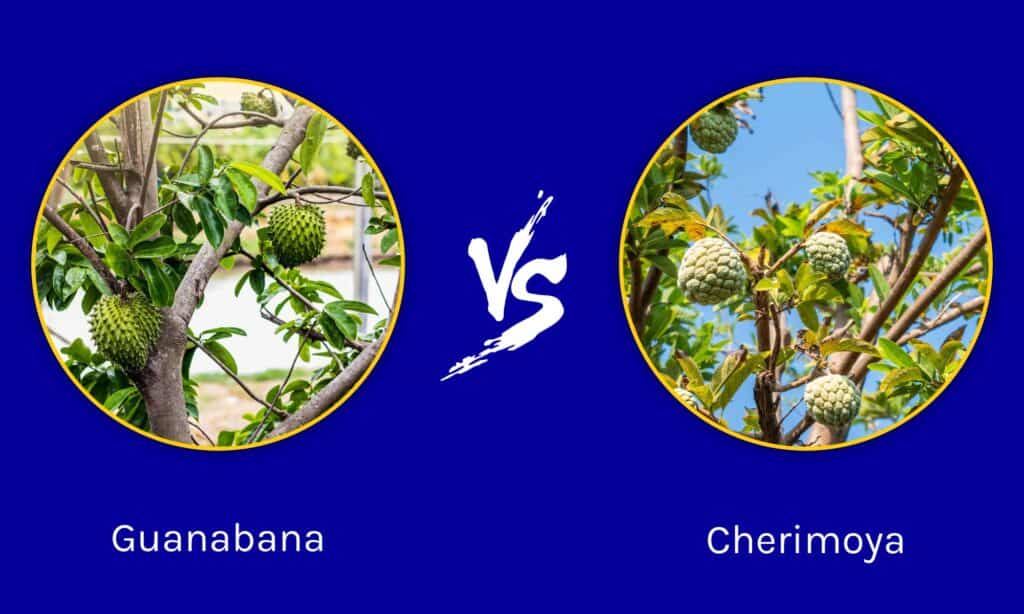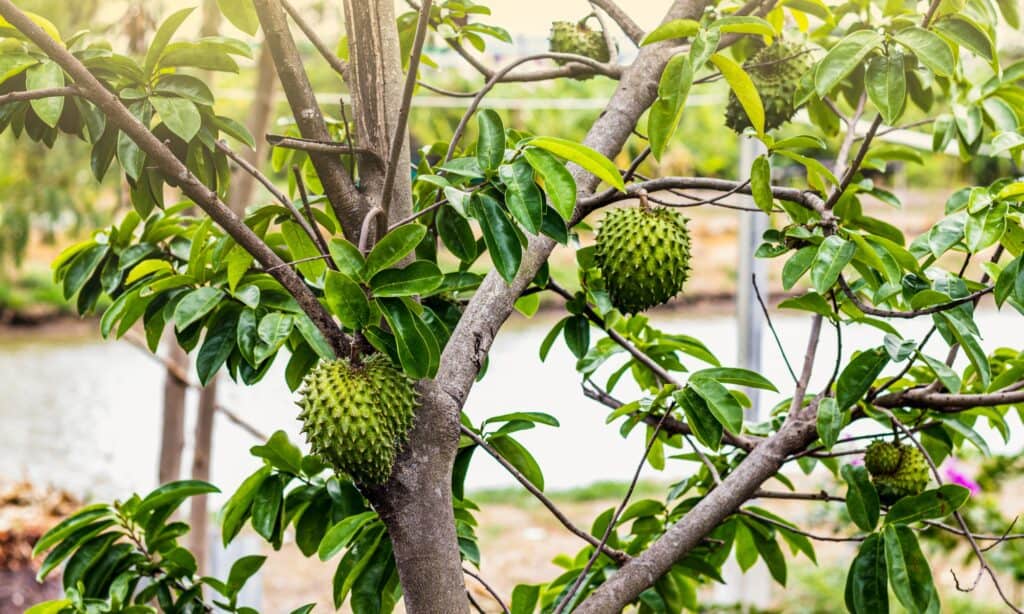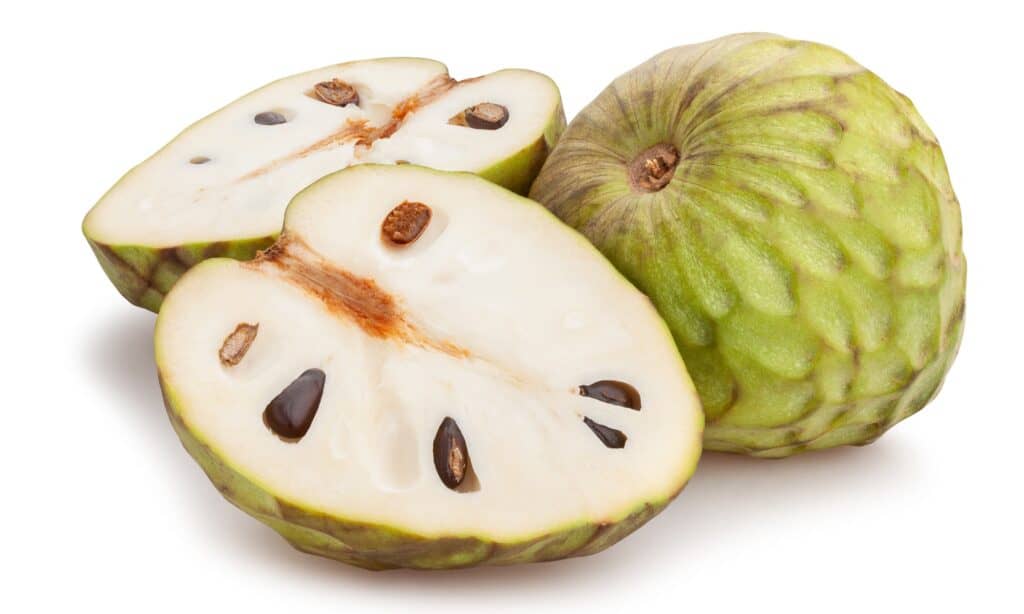Guanabana and cherimoya are two delicious tropical fruits often mistaken for one another. They are both members of the same plant family and genus, Annona, which means they are technically a related species. The similarities don’t end there, though. Both trees can grow up to 30 feet, and their fruits also have striking similarities in their taste profiles. Both guanabana and cherimoya fruits are soft when ripe and are excellent sources of antioxidants. However, these two trees are actually quite different. So, what sets them apart?
In this article, we will take a closer look at the distinctive features of guanabana and cherimoya to see how they measure up against each other in terms of description, taste, origin, and more! Keep reading to find out!
Comparing Guanabana vs. Cherimoya

| Guanabana | Cherimoya | |
|---|---|---|
| Plant Classification | Kingdom: Plantae Clade: Tracheophytes Clade: Angiosperms Clade: Magnoliids Order: Magnoliales Family: Annonaceae Genus: Annona Species: Annona muricata | Kingdom: Plantae Clade: Tracheophytes Clade: Angiosperms Clade: Magnoliids Order: Magnoliales Family: Annonaceae Genus: Annona Species: Annona cherimola |
| Common Names | Graviola, Brazilian pawpaw, Sirsak, Guyabano, Soursop, Prickly custard apple | Custard apple, Chirimoya, Chirimolla |
| Native | Native to South American tropical regions, the Caribbean, West Indies | Native to Southern Ecuador and Northern Peru |
| Distribution | – Warm lowlands of Africa, temperate and tropical regions in Asia, North America, and Pacific regions – Grows on calcareous plains and forest clearings | – Tropical and subtropical regions in Central America, South America, South Asia, North Africa, Southern California, and Australia |
| Description | – Trees are evergreen reaching about 30 feet tall – Dark green and oblong- oval leaves measuring 3.1 to 6.3 inches long and without hairs – Hairy branches and thick, fleshly, and greenish-yellowish flowers – Fruits are syncarps, ovoid-oblong, curved when fresh green, and can measure up to 15 inches with a weight of 15 pounds. The fruit flesh is whitish | – The trees are lowly-branched, fast-growing, and evergreen, growing up to 30 feet or more – Young branches covered with rust-colored hairs but get sappier and woodier as they mature – Leathery leaves measuring 2-9 inches long and pale green flowers measuring 1.2 inches long – The fruits are conical or heart-shaped, with overlapping scales, and may weigh up to 10 pounds |
| Uses | – Cultivated for its edible fruits, which are used to make smoothies, fresh fruit juices, and ice cream flavorings – Used as herbal medicine and as tea leaves | – Used as an ornamental tree-Fruits are essentially eaten fresh and used in fruit salads and dessert recipes, used for fruit juice drinks, ice cream flavorings, and milkshakes – Immature fruits used for making vegetable curries |
The Key Differences Between Guanabana and Cherimoya
While guanabana and cherimoya look very similar, with greenish skin and whitish flesh, there are a few significant differences between the two. Both fruits’ classification, taste, origin, and uses are quite different.
Here’s a rundown of key differences that can help you distinguish the two.
Guanabana vs. Cherimoya: Classification

Guanabana belongs to the
Annona muricataspecies.
©iStock.com/Raywatt Jhantarangura
Both guanabana and cherimoya are members of the same genus, Annona, also called the custard-apple genus, which includes about 119 species of flowering plants in the botanical family Annonaceae. Despite belonging to the same genus and family, guanabana and cherimoya belong to different species. Guanabana belongs to the Annona muricata species, while cherimoya belongs to Annona cherimola, an edible fruit-bearing plant species.
Guanabana vs. Cherimoya: Description

Cherimoya fruits are covered in scales.
©iStock.com/bergamont
Guanabana and cherimoya trees are approximately the same height and can grow up to 30 feet long. However, you can distinguish these two species by their branches, leaves, and fruits. Cherimoya leaves are much larger than guanabana leaves. While cherimoya leaves are 2.0 – 9.8 inches long and 1.2 – 3.9 inches in width, guanabana leaves can reach 3.1 – 6.3 inches long and 1.2 – 2.8 inches in width. Still, on leaflets, guanabana leaflets are ovate, dark green, glossy, and smooth with no hairs, while cherimoya leaflets are leathery and mostly covered with rust-colored hairs on the top surface.
Another noticeable difference between these two plant species is their flowers and color. Guanabana has yellowish flowers, triangular-conical and short-stalked, ranging between 1.5 – 2 inches long. They are borne singly in clusters and may appear on the trunk, branches, or twigs. In contrast, the cherimoya tree has light green solitary flowers, emerging in groups of two or three on the stalks or the branches.
Though guanabana and cherimoya fruits are somewhat heart-shaped, cherimoya is slightly smaller and more conical, while guanabana is larger and more or less oval-shaped. Regarding taste, cherimoya fruit is sweet and candy-like, with a flavor that most sources described as similar to strawberry, peaches, pawpaws, pineapple, or banana. On the other hand, the guanabana has an agreeable subacid and custard-like flavor that has been likened to a cross between a banana and a pineapple.
Guanabana vs. Cherimoya: Origin and Distribution
With its origins in the West Indies, the Caribbean, and northern South America, guanabana is today abundant throughout the lowland areas in the West Indies, southern Mexico, Peru, and Argentina. Some studies suggest that guanabana is also among the first fruit trees to be carried from America across the Old World Tropics before gaining importance in the markets of southeastern China, Australia, southeast Asia, and the warm lowlands of eastern and western Africa. The tree is also common in Pacific Islands.
In a similar way to guanabana, according to historians, cherimoya originates from southern Ecuador and northern Peru. Nowadays, its cultivation has spread to Chile, Brazil, the temperate regions of Costa Rica, Central America, Argentina, and Spain.
Guanabana vs. Cherimoya: Uses

Cherimoya trees are used as ornamental trees because of their fragrant blooms.
©iStock.com/powerbeephoto
Commonly known for its edible fruits, the flesh of the ripe guanabana is used in fruit salads or for making syrup, sherbet, smoothies, and ice cream flavorings. The fruit is also used in making alcoholic guanabana, also known as graviola, thanks to its tart and acidic taste. The leaves and roots of the guanabana plant are used in traditional medicine. Some people believe that guanabana can treat cancer, but no scientific evidence supports this claim.
On the other side, cherimoya trees are used as ornamental trees because of their fragrant blooms. Cherimoya seeds are crushed to make insecticides, while dried flowers are used as a flavoring for snuff, especially in Jamaica. Cherimoya is used in Mexican traditional medicine.
Up Next:
- Sugar Apple vs Cherimoya
- Guanabana vs. Guava: 5 Key Differences
- Cherimoya vs Soursop: Is There a Difference?
The photo featured at the top of this post is © iStock.com/powerbeephoto
Sources
- CABI, Available here: https://www.cabi.org/isc/datasheet/5812#7352a358-76a1-44ef-a143-9d802fa63386
- Stuart Xchange, Available here: http://www.stuartxchange.org/Cherimoya
- National Library of Medicine, Available here: https://pubmed.ncbi.nlm.nih.gov/28216899/
- Science Direct, Available here: https://www.sciencedirect.com/topics/agricultural-and-biological-sciences/annona-muricata
Thank you for reading! Have some feedback for us? Contact the AZ Animals editorial team.






